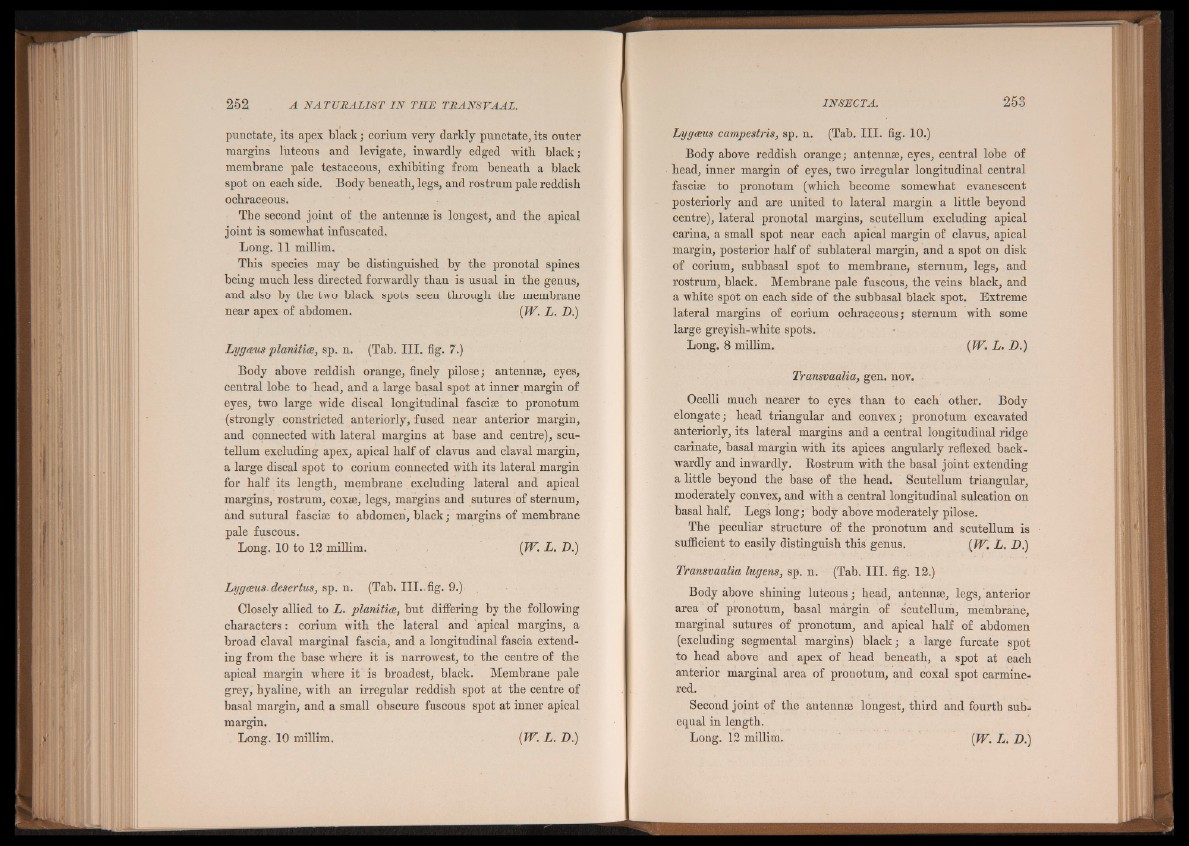
punctate, its apex black; corium very darkly punctate, its outer
margins luteous and levigate, inwardly edged with black;
membrane pale testaceous, exhibiting from beneath a black
spot on each side. Body beneath, legs, and rostrum pale reddish
ochraceous.
The second joint of the antennae is longest, and the apical
joint is somewhat infuscated.
Long. 11 millim.
This species may be distinguished by the pronotal spines
being much less directed forwardly than is usual in the genus,
and also by the two black spots seen through the membrane
near apex of abdomen. (W. L. D.)
Lygaus planitice, sp. n. (Tab. III. fig. 7.)
Body above reddish orange, finely pilose; antennae, eyes,
central lobe to head, and a large basal spot at inner .margin of
eyes, two large wide discal longitudinal fasciae to pronotum
(strongly constricted anteriorly, fused near anterior margin,
and connected with lateral margins at base and centre), scu-
tellum excluding apex, apical half of clavus and claval margin,
a large discal spot to corium connected with its lateral margin
for half its length, membrane excluding lateral and apical
margins, rostrum, coxae, legs, margins and sutures of sternum,
and sutural fasciae to abdomen, black; margins of membrane
pale fuscous.
Long. 10 to 12 millim. (W’. L. D.)
Lygmis-desertus, sp. n. (Tab. III..fig. 9.)
Closely allied to L. planitice, but differing by the following
characters: corium with the lateral and apical margins, a
broad claval marginal fascia, and a longitudinal fascia extending
from the base where it is narrowest, to the centre of the
apical margin where it is broadest, black. Membrane pale
grey, hyaline, with an irregular reddish spot at the centre of
basal margin, and a small obscure fuscous spot at inner apical
margin.
Long. 10 millim. (TV. L. D.)
Lygaus campestris, sp. n. (Tab. III. fig. 10.)
Body above reddish orange; antennse, eyes, central lobe of
head, inner margin of eyes, two irregular longitudinal central
fasciae to pronotum (which become somewhat evanescent
posteriorly and are united to lateral margin a little beyond
centre), lateral pronotal margins, scutellum excluding apical
carina, a small spot near each apical margin of clavus, apical
margin, posterior half of sublateral margin, and a spot on disk
of corium, subbasal spot to membrane, sternum, legs, and
rostrum, black. Membrane pale fuscous, the veins black, and
a white spot on each side of the subbasal black spot. Extreme
lateral margins of corium ochraceous; sternum with some
large greyish-white spots.
Long. 8 millim. (TV. L. D.)
Transoaalia, gen. nov.
Ocelli much nearer to eyes than to each other. Body
elongate; head triangular and convex; pronotum excavated
anteriorly, its lateral margins and a central longitudinal ridge
carínate, basal margin with its apices angularly reflexed back-
wardly and inwardly. Rostrum with the basal joint extending
a little beyond the base of the head. Scutellum triangular,
moderately convex, and with a central longitudinal sulcation on
basal half. Legs long; body above moderately pilose.
The peculiar structure of the pronotum and scutellum is
sufficient to easily distinguish this genus. (TV. L. D.)
Transvaalia lugens, sp. n. (Tab. III. fig. 12.)
Body above shining luteous; head, antennse, legs, anterior
area of pronotum, basal margin of scutellum, membrane,
marginal sutures of pronotum, and apical half of abdomen
(excluding segmental margins) black; a large furcate spot
to head above and apex of head beneath, a spot at each
anterior marginal area of pronotum, and coxal spot carmine-
red.
Second joint of the antennse longest, third and fourth sub-
equal in length.
Long. 12 millim. ' (W. L. D.)